Papers by ABDULHALIM M U S A ABUBAKAR
Stevia (Rebaudiana bertoni) leave is an ancient perennial shrub mostly found in South America (es... more Stevia (Rebaudiana bertoni) leave is an ancient perennial shrub mostly found in South America (especially Brazil and Paraguay). It contains a low-calorie sweetener, which is about 300 times sweeter than sucrose. Natural sweeteners extracted from plant and artificial or synthetic sweeteners produced from industires, are the two types of sweeteners that are available. Sweetening agents induce and enhance sweet taste which makes it favorable for consumption. Natural sweetening agents are more advisable to use than artificial sweetening agents because they do not have any side effect and is of no harm to health. In this work, the background of stevia leave, uses, and extraction of natural sweetener is reviewed.
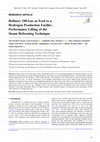
Archives of Advanced Engineering Science
Refinery off-gas is one of the major causes of air pollution, where its reuse, through channeling... more Refinery off-gas is one of the major causes of air pollution, where its reuse, through channeling into other plant setups to recover some of its constituent gases (via a steam reforming technique), is described as one of its best handling measures. A nominal off-gas containing 2.898% hydrogen (H2), 83.794% methane, 1.505% carbon dioxide, 1.103% nitrogen, 10.6% sulfur and 0.1% argon was fed to a plant to produce 37.52 kg of H2. To lift the performance of the multiple interconnected process units enhancing the generation of H2, temperature and pressure in the reactors were manipulated against the heat duty and H2 yield, where it was found that the two dependent variables are sensitive to changes made during Aspen Plus sensitivity analysis. Replacing some process units also shows significant improvement in the recovery of H2 gas. Adequate control of the synthesis process as exemplified in this work, will lead to smooth realization of the target end-product which is of high economic val...
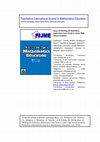
Polyhedron International Journal in Mathematics Education
Each student has their own characteristics and way of doing 3D geometric thinking. The way of thi... more Each student has their own characteristics and way of doing 3D geometric thinking. The way of thinking that students do influences the resulting understanding of the concept of 3D geometry. Therefore, this study aims to investigate students' geometric thinking based on the level of achievement of students in completing the 3D geometric thinking ability test (3D GTA). This study uses an exploratory case study design. The participants who voluntarily participated were 33 junior high school students (14 boys, 19 girls) in one of the schools in Indramayu Regency, Indonesia. Data obtained from the process of observation, tests, interviews, and documentation were analyzed qualitatively using Atlas. ti 8 software. The findings revealed that students with low 3D GTA achievements experienced difficulties in representing and calculating the surface area and volume of 3D shapes. In addition, students with moderate 3D GTA achievements experienced difficulties in representing 3D shapes but w...
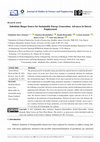
Journal of Studies in Science and Engineering
The growing need for sustainable energy generation has sparked interest in exploring alternative ... more The growing need for sustainable energy generation has sparked interest in exploring alternative biogas sources. In recent years, insects have emerged as a promising substitute for traditional feedstocks in biogas production due to their high protein and lipid content, rapid growth rate, and low environmental impact. This literature review aims to provide an overview of the advances in insect employment for sustainable energy generation. It presents a comprehensive analysis of the existing literature, highlighting the potential of insects as viable and renewable biogas sources, the challenges associated with insect rearing and processing, and the technological innovations in optimizing their utilization. The review also discusses the economic viability and environmental benefits of employing in-sects in biogas production and future research directions in this emerging field. The nutrient content of fermentable or biodegradable organic materials will serve as an ingredient in the pro...
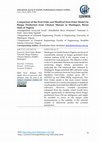
International Journal of Scientific Multidisciplinary Research
Maiduguri in North-Eastern Nigeria can boost of considerable amount of biogas generated from chic... more Maiduguri in North-Eastern Nigeria can boost of considerable amount of biogas generated from chicken manure (CM) if the organic waste is exploited for such purposes. The objective of this work is to determine the most accurate model for predicting biogas kinetic parameters by analyzing the CM empirical data obtained in Maiduguri. Biogas potential (BP) estimates using NLREG 6.6 software from the First Order and the Modified First-Order models gives BP = 10252217.1g and 83861.2925g respectively. The First Order model is the most correct kinetic model based on a careful assessment of statistical results gotten from both the ORIGIN and NLREG softwares. However, constant parameters estimated from the models, which would have helped significantly in optimizing future biogas production from CM are ambiguous and might be ascribed to errors in the biogas yield measurements or the inability of the selected models to effectively predict the constant parameters

International Journal of Multidisciplinary Approach Research and Science
Stevia (Rebaudiana bertoni) leave, is an ancient perennial shrub mostly found in South America in... more Stevia (Rebaudiana bertoni) leave, is an ancient perennial shrub mostly found in South America in countries like Paraguay and Brazil. It contains a low-calorie sweetener, which is about 300 times sweeter than sucrose. Diabetes mellitus is among the common metabolic disorders affecting about 2.8% of the world’s population and is reported to reach 5.4% by the year 2025. In this work, insulin was successfully extracted from Rebaudiana bertoni to serve as an alternative to bovine insulin extracted from animals which is devoid of the risk of transferring infectious diseases from the animals to the diabetic patient as is the case with convectional animal-based insulin. Gas Chromatography-Mass Spectroscopy (GC-MS) and Fourier Transform InfraRed (FTIR) analysis were used to analyze and determine the functional groups available in the isolated compound and the results shows that it has retention time of 14.11 min; abundance/peak area (% PA) of 86.613 %; mass number (m/z) of 413 g/mol; molecu...
Journal of Chemistry and Environment
This study aims to produce activated carbon (AC) from different biomass sources using chemical ac... more This study aims to produce activated carbon (AC) from different biomass sources using chemical activation; characterize the AC using Fourier Transform Infrared (FTIR) Spectroscopy, Scanning Electron Microscopy (SEM), proximate and ultimate analysis; and compare the results from the AC produced. The biomass blends of rice husk & groundnut shell (RH-GS), cocoa nut shell & saw dust (CS-SD) and sugar cane bagasse & banana peel (SB-BP) were used for the preparation of AC. The samples were first characterized using proximate and ultimate analysis, SEM, and FTIR spectroscopy. The results of the BG-SD sample characterization showed that the blend produced the best results in terms of absorptive capacity. It is suggested that surface area difficulties with the ACs be investigated in order to improve their porosity and adsorption capacities.

Logistic and Operation Management Research (LOMR)
Sulphuric acid (H2SO4) is of immense importance to the chemical industry and humanity. The use of... more Sulphuric acid (H2SO4) is of immense importance to the chemical industry and humanity. The use of Aspen Plus modeling, simulation, and optimization via the contact process has enabled the production of grade sulphuric acid. Notably, the research findings highlight the sensitivity of water flow rate to the maximization of H2SO4 production. Through these methods, a production capacity of around 8 tons per day was achieved, with a purity level of 98.9%. This achievement significantly contributes to meeting the demand for sulphuric acid in various industries. Moreover, exploring alternative sourcing methods, such as utilizing elemental sulphur, offers the potential for further optimizing H2SO4 production. The benefits of improving H2SO4 production extend beyond the chemical industry. Sulphuric acid finds applications in agriculture, petroleum refining, pharmaceuticals, and metal processing. Enhancing the production process ensures a reliable supply for these sectors. In summary, sulphur...
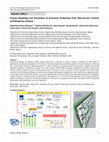
Journal of Technology Innovations and Energy
Optimal production of ammonia (NH3) using natural gas is necessary in order to make it available ... more Optimal production of ammonia (NH3) using natural gas is necessary in order to make it available for wide range of applications including the manufacture of fertilizers, fuel for transportation and during synthesis of some chemicals. Achieving this would require strategic implementation of a control scheme to simulated ammonia production, capable of ensuring adequate realization of production targets. The work involves ASPEN Plus modeling, simulation, sensitivity analysis and control of NH3 production process. Steam/carbon ratio, conversion of CH4, removal of carbon dioxide (CO2) and carbon monoxide (CO), hydrogen/nitrogen ratio and heat exchanger and separator temperatures were identified as requiring control in units any of these specifically impacts. As a result, approximately 176 tons of NH3 was realized daily based on the simulation results and can be scaled-up using a calculated factor equivalent to 1.1375 to 200 tons/day capacity, in this design. Sensitivity analysis resultin...

Zenodo (CERN European Organization for Nuclear Research), Dec 15, 2022
Simulation modeling of microbial proliferation had increased in recent years using Monod and adva... more Simulation modeling of microbial proliferation had increased in recent years using Monod and advanced kinetic models. Accurate data is limited to advance studies in cell utilization for various applications due to complexity of the process. In this reasearch, behaviour of the Monod parameters at different substrate and biomass levels will be examined using predicted data obtained originally from empirical observations. Method involves deliberate variation of some variables to examine its effects on others starting from the basic Malthus equation. Results shows that, predicted data are more convinient and clearly presents the supposed dynamics of the process compared to ideal experimental results. By implications, improved procedures are necessary to allow for precise estimates of basic cell numbers and substrate concentration values.
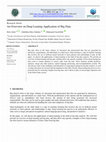
Mesopotamian Journal of Big Data
Big data refers to the large volumes of structured and unstructured data that are generated by bu... more Big data refers to the large volumes of structured and unstructured data that are generated by businesses, organizations, and individuals on a daily basis. Deep learning is a type of machine learning that involves the use of artificial neural networks to learn patterns and relationships in data. In this paper, we discuss the applications of deep learning in the field of big data analysis. We provide an overview of deep learning and big data, and then delve into specific examples of how deep learning has been used in various domains to extract value from big data. These domains include predictive analytics, image and video analysis, natural language processing, and recommendation systems. We also discuss some of the challenges and limitations of using deep learning for big data analysis, as well as future directions for research and development in this field. Overall, deep learning has proven to be a powerful tool for extracting insights from big data, and is likely to play an increa...
iRASD Journal of Energy & Environment
Kinetic study of microorganism’s growth in chicken manure (CM) when producing biogas is often stu... more Kinetic study of microorganism’s growth in chicken manure (CM) when producing biogas is often studied for scale-up purposes. CM are considered as waste, and can cause serious environmental consequences when not properly disposed. The objective of the study is to know the characteristics of the bioreactor condition or environment responsible for CM degradation and biogas production. Methods involves serial dilution, pour plating, cell count and the determination of Monod parameters. POLYMATH regression results shows that CM of particle density 0.0163 g/cm3 gives a maximum specific growth rate, ?_max of 0.007316 hr^(-1) and half saturation constant, K_s of 3.8×?10?^8mg/l which points to substrate sufficiency for the survival of microorganisms and biogas production.
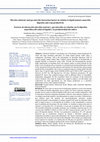
Tesla Revista Científica
El costo cada vez mayor de los fertilizantes químicos se está convirtiendo en un cuello de botell... more El costo cada vez mayor de los fertilizantes químicos se está convirtiendo en un cuello de botella importante para el cultivo de tierras agrícolas pequeñas y grandes, de las cuales el estiércol líquido (LM) ofrece una ventaja comparativa. LM es el producto final de la digestión anaeróbica (AD) de varias materias orgánicas y/o su compost mezclado manual o mecánicamente en zanjas excavadas o biorreactores que utilizan agua. En general, los microorganismos presentes ayudan significativamente a descomponer la materia orgánica del suelo en nutrientes útiles para la supervivencia y el crecimiento de la planta, ya que la humedad es esencial para la proliferación bacteriana. En este trabajo, se examina la interacción entre el sustrato y el microbio (N) y el microbio y el gas que se produce (K) en el sistema AD mesófilo utilizando un modelo existente. Los resultados muestran que N y K oscilan entre 0,00046 y 0,0016 y 0,1643 y 0,1987, respectivamente, entre 25 y 45 ℃ para LM digerido durante ...

International Journal of Research In Science & Engineering
Several microorganisms are there in chicken manure (CM) but Salmonella, Cryptosporidium and Esche... more Several microorganisms are there in chicken manure (CM) but Salmonella, Cryptosporidium and Escheridia coli are the most identified. Objective of this research includes, carrying out microbial count in the CM substrate for 40 days retention time in a digester, uterlizing kinetic expressions satisfying the process and fitting results obtained with 26 existing microbial growth kinetic models. Results shows that microbes inside the CM slurry, survived for a full period of 37 days divided into 7 days of acclimatization, 23 days of growth and another 7 days of equal rate of death and multiplication. Findings shows that the maximum specific growth rate, ????????????????, estimated from the basic Monod equation, of the organisms is 0.0076hr-1 and the half-saturation constant, ????????, is ????. ???????????? × ???????????? mg/l which indicates how sufficient the substrate concentration is for the bacteria to feed on. Not all 26 growth kinetic models found in the literature fit the measured ...
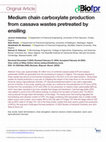
Biofuels, Bioproducts and Biorefining, 2023
Every year, approximately 35 million tons of combined cassava peels (CP) and cassava
wastewater... more Every year, approximately 35 million tons of combined cassava peels (CP) and cassava
wastewater (CWW) are generated from the processing of cassava in Nigeria. The improper disposal of these wastes has serious environmental consequences in the form of air and water pollution. Using these wastes for biofuel production is one way of mitigating the impact of the mass flows on the environment. However, being a lignocellulosic biomass, CP requires pretreatment before it can yield a reasonable amount of biofuel. In this study, ensiling was chosen as a method for the pretreatment of CP slurry (CPS), formed from the combination of CP and CWW, for the production of medium-chain carboxylates (MCCs), which have been reported to be more valuable than biogas and bioethanol. Calcined egg shells (CES) were added to some of the CPS before ensiling, to enhance the formation of butyric acid. The MCCs were produced through batch fermentation of the silage. The results show that ensiling degraded the hemicellulose and cellulose content of CPS. The silage containing CES had greater loss of volatile solids, higher butyric acid content, and a higher MCCs (C6-C8) yield of 210gkg-1VS while the silage without CES had an MCC yield of 137gkg-1VS. Out of the three kinetic models that were used to predict the production of MCCs, the dual pool model gave the best prediction.
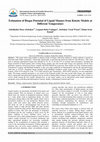
Ehime, 2022
The target when using models to analyse results of biogas yield from manure or similar substrate ... more The target when using models to analyse results of biogas yield from manure or similar substrate is mostly to determine their kinetic parameters, which help significantly in knowing the bioreactor behavior and efficiency. This work aims at utilizing experimental biogas data obtained at 25, 30, 35, 40 and 45℃ to estimate these parameters, including the biogas potential of liquid manure from existing biogas models, first and second order biogas rate equations and the basic arithmetic equations using Excel Solver coupled with POLYMATH by regression. Best models are Cone, Proposed model, Transference, Logistic and Modified Gompertz as they give high coefficient of determination and fits the measured biogas yield data at 25-45℃. Estimated biogas potential from Modified Gompertz model ranges from 7143-13584 mL/gVS; Logistic, 6556-12779 mL/gVS; Cone, 7713-14403 mL/gVS and; Transference, 35639-44932 mL/gVS, over the temperature range. The biogas potential parameter is not found in the Proposed model, first and second order biogas rate equations, linear, exponential and polynomial equations but are useful in finding fitted estimates of the empirical data. Most accurate or correct model among the best models obtained here, as per future studies, can be determined using model comparison parameters such as the Bayesian Information Criterion, Akaike's Information Criterion and F-test.

CERN European Organization for Nuclear Research - Zenodo, Apr 30, 2022
The target when using models to analyse results of biogas yield from manure or similar substrate ... more The target when using models to analyse results of biogas yield from manure or similar substrate is mostly to determine their kinetic parameters, which help significantly in knowing the bioreactor behavior and efficiency. This work aims at utilizing experimental biogas data obtained at 25, 30, 35, 40 and 45℃ to estimate these parameters, including the biogas potential of liquid manure from existing biogas models, first and second order biogas rate equations and the basic arithmetic equations using Excel Solver coupled with POLYMATH by regression. Best models are Cone, Proposed model, Transference, Logistic and Modified Gompertz as they give high coefficient of determination and fits the measured biogas yield data at 25-45℃. Estimated biogas potential from Modified Gompertz model ranges from 7143-13584 mL/gVS; Logistic, 6556-12779 mL/gVS; Cone, 7713-14403 mL/gVS and; Transference, 35639-44932 mL/gVS, over the temperature range. The biogas potential parameter is not found in the Proposed model, first and second order biogas rate equations, linear, exponential and polynomial equations but are useful in finding fitted estimates of the empirical data. Most accurate or correct model among the best models obtained here, as per future studies, can be determined using model comparison parameters such as the Bayesian Information Criterion, Akaike's Information Criterion and F-test.
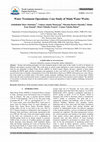
CERN European Organization for Nuclear Research - Zenodo, Oct 9, 2022
Design and working principles of water treatment plants in other parts of the world, as well as i... more Design and working principles of water treatment plants in other parts of the world, as well as in Nigeria are different and requires extensive study. This work looks at current trends undergone in water treatment plants in contrast with the one obtainable at Mada Water Works (MWW) in North Central, Nigeria. Because, majority of these plants including the MWW apply obsolete techniques and equipment, as they were built in the early 1980s and 1990s. Previous research only looks at metallic contamination levels of the Mada River which serve MWW with unclean raw water. Hence, this work entails an in-depth study of the plant's modus operandi, challenges faced and ways of solving them. Studies shows that the entire treatment plant needs a complete turnaround to prevent it from eminent system collapse. The attention of researchers is therefore drawn to the treatment plant's various unit operation in order to address challenges facing their functionality.
CERN European Organization for Nuclear Research - Zenodo, Oct 16, 2021
The knowledge of nutrient composition of specific substrate(s) for anaerobic digestion for the pr... more The knowledge of nutrient composition of specific substrate(s) for anaerobic digestion for the production of biogas can provide first-hand information on the possible outcome of digesting such feedstock. It will also help in planning the construction of large-scale biogas plants based on the awareness of the substrates output quantity of biodegradation products. This paper aims to present feedstock information, yield of the bioprocess and bioenergy capacity of products from anaerobic digestion for comparison, studies and analysis.

CERN European Organization for Nuclear Research - Zenodo, Nov 5, 2022
Globally, the first use of placentas to generate energy was at Perpetual Succor Hospital, Cebu Ci... more Globally, the first use of placentas to generate energy was at Perpetual Succor Hospital, Cebu City, Philippines. Currently, placentas are objects of rituals in many countries of the world. They are either planted beside trees of attached significance to the family or consumed in some instances. This study examines this practice, and its alternative channeling into digesters to produce bioenergy. Previous research on biodigesters constructed near Mwananyamala Regional Hospital, Tanzania and the Bir Hospital, Kathmandu, Nepal, generates 2.5 m 3 and 5.78 m 3 respectively of biogas daily from co-digestion of placenta and food waste. Its main use is to power the healthcare facility and generate gas to boil water needed by patients. But the utilization of placentas as sole biogas feedstock for energy generation hasn't been carried out.









Uploads
Papers by ABDULHALIM M U S A ABUBAKAR
wastewater (CWW) are generated from the processing of cassava in Nigeria. The improper disposal of these wastes has serious environmental consequences in the form of air and water pollution. Using these wastes for biofuel production is one way of mitigating the impact of the mass flows on the environment. However, being a lignocellulosic biomass, CP requires pretreatment before it can yield a reasonable amount of biofuel. In this study, ensiling was chosen as a method for the pretreatment of CP slurry (CPS), formed from the combination of CP and CWW, for the production of medium-chain carboxylates (MCCs), which have been reported to be more valuable than biogas and bioethanol. Calcined egg shells (CES) were added to some of the CPS before ensiling, to enhance the formation of butyric acid. The MCCs were produced through batch fermentation of the silage. The results show that ensiling degraded the hemicellulose and cellulose content of CPS. The silage containing CES had greater loss of volatile solids, higher butyric acid content, and a higher MCCs (C6-C8) yield of 210gkg-1VS while the silage without CES had an MCC yield of 137gkg-1VS. Out of the three kinetic models that were used to predict the production of MCCs, the dual pool model gave the best prediction.
wastewater (CWW) are generated from the processing of cassava in Nigeria. The improper disposal of these wastes has serious environmental consequences in the form of air and water pollution. Using these wastes for biofuel production is one way of mitigating the impact of the mass flows on the environment. However, being a lignocellulosic biomass, CP requires pretreatment before it can yield a reasonable amount of biofuel. In this study, ensiling was chosen as a method for the pretreatment of CP slurry (CPS), formed from the combination of CP and CWW, for the production of medium-chain carboxylates (MCCs), which have been reported to be more valuable than biogas and bioethanol. Calcined egg shells (CES) were added to some of the CPS before ensiling, to enhance the formation of butyric acid. The MCCs were produced through batch fermentation of the silage. The results show that ensiling degraded the hemicellulose and cellulose content of CPS. The silage containing CES had greater loss of volatile solids, higher butyric acid content, and a higher MCCs (C6-C8) yield of 210gkg-1VS while the silage without CES had an MCC yield of 137gkg-1VS. Out of the three kinetic models that were used to predict the production of MCCs, the dual pool model gave the best prediction.